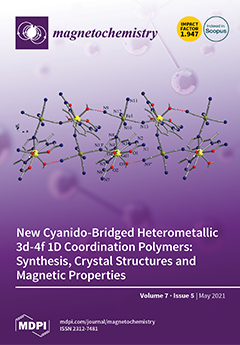Structural, microstructural, and magnetic properties of Heusler Ni
50Mn
50−xIn
x (x = 5 and 10) ribbons have been investigated by X-ray diffraction (XRD), scanning electron microscopy (SEM) coupled with energy dispersive X-ray spectroscopy (EDS), differential scanning calorimetry (DSC), and vibrating
[...] Read more.
Structural, microstructural, and magnetic properties of Heusler Ni
50Mn
50−xIn
x (x = 5 and 10) ribbons have been investigated by X-ray diffraction (XRD), scanning electron microscopy (SEM) coupled with energy dispersive X-ray spectroscopy (EDS), differential scanning calorimetry (DSC), and vibrating sample magnetometry (VSM). The as quenched Ni
50Mn
45In
5 ribbons exhibit a mixture of monoclinic
14M (a = 4.329(3) Å, b = 5.530(3) Å, and c = 28.916(3) Å), and tetragonal
L10 (a = b = 3.533(3) Å, and c = 7.522(3) Å) martensite structures, while Ni
50Mn
40In
10 ribbons display a single monoclinic
14M phase (a = 4.262(3) Å, b = 5.692(3) Å, and c = 29.276(3) Å). After three heating/cooling cycles, in the temperature range of 303–873 K, the Rietveld refinement of the XRD patterns revealed the presence of a single
14M martensite for Ni50Mn45In5 ribbons, and a mixture of cubic
L21 (31%) and
14M (69%) phases for Ni
50Mn
40In
10 ribbons. The characteristic temperatures of the martensitic transition (
Astart,
Afinish,
Mstart, and
Mfinish), the thermal hysteresis temperature width, and the equilibrium temperature decreased with increasing indium content and heating cycles. The samples show a paramagnetic like behavior in the as quenched state, and a ferromagnetic like behavior after the third heating/cooling cycle.
Full article





